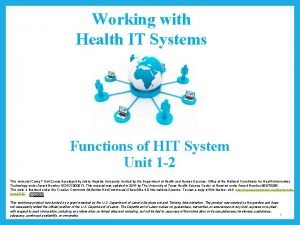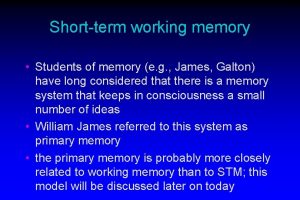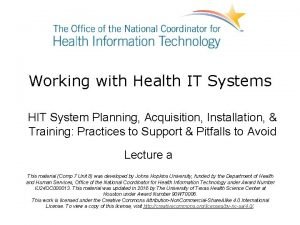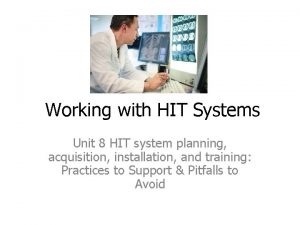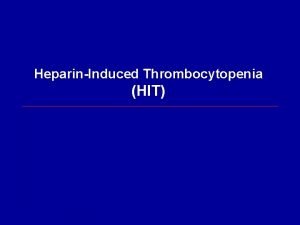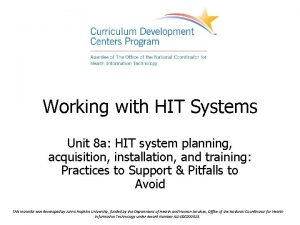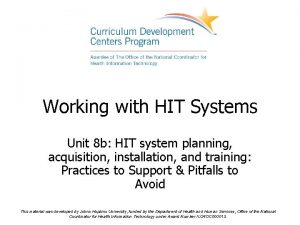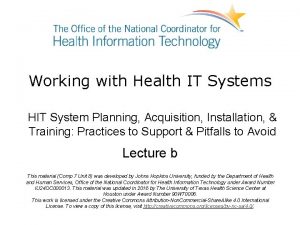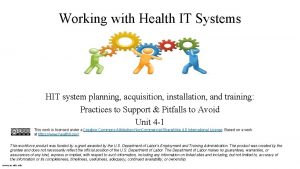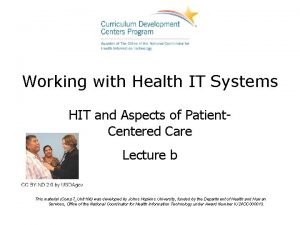Working with Health IT Systems HIT System Planning












- Slides: 12

Working with Health IT Systems HIT System Planning, Acquisition, Installation, & Training: Practices to Support & Pitfalls to Avoid Lecture b This material (Comp 7 Unit 8) was developed by Johns Hopkins University, funded by the Department of Health and Human Services, Office of the National Coordinator for Health Information Technology under Award Number IU 24 OC 000013. This material was updated in 2016 by The University of Texas Health Science Center at Houston under Award Number 90 WT 0006. This work is licensed under the Creative Commons Attribution-Non. Commercial-Share. Alike 4. 0 International License. To view a copy of this license, visit http: //creativecommons. org/licenses/by-nc-sa/4. 0/.

HIT System Planning, Acquisition, Installation, & Training: Practices to Support & Pitfalls to Avoid Learning Objectives – Lecture b • Conduct a basic user needs analysis for a given example situation. • Create a plan for training users in a small office practice, a large community clinic, or a single unit in an ambulatory care setting. • Identify several potential challenges that may emerge during installation and generate a strategy to solve (lack of basic computer literacy in staff, etc. ). 2

Training • Timing is important • Incorporate a “practice” version of the system • Design to meet the needs of different roles within the organization 3

More Training • People prefer to learn in different ways – Just-in-time (by function), or full immersion – Classroom-based or online – Instructor-led or self-paced – Group-based or one-on-one • Accommodate differing schedules • Determine the best people to deliver the training 4

Even More Training! • Keys to success – Convenient locations – Focused curriculum – Flexible, knowledgeable trainers • Training starts early, continues through operational stage 5

Key Success Factors • Readiness of the organization; prepared to: – Understand what the system can do – Investigate and choose a system – Implement system – Training – Monitor the system • Availability of a champion • Perceived usefulness of the system • Organizational teamwork – For small practice settings, change occurs from within the staff rather than from the top – People skills are as important as the technology 6

Tools for Skilled Nursing Facilities & Long-Term Care Toolkit Stratis Health http: //www. stratisheal th. org/expertise/healt hit/nursinghomes/nht oolkit. html Hunt, 2007, CC-BY-SA-NC 2. 0 7

Tools for Small Provider Practices Toolkits • DOQ-IT (“Dock-it”) http: //www. himss. org/Resource. Library/Resource Detail. aspx? Item. Number=10725 • Health Information Technology Toolkit for Physician Offices: http: //www. stratishealth. org/expertise/healthit/cli nics/clinictoolkit. html 8

Tools for Community Health Clinics & Safety Nets Toolkit • Stratis Health http: //www. stratishealth. org/expertise/healthit/ho spitals/htoolkit. html 9

HIT System Planning, Acquisition, Installation, & Training: Practices to Support & Pitfalls to Avoid Summary – Lecture b • Core concepts of HIT systems planning, acquisition, installation and training • Apply core concepts to specific health care settings • Implementation challenges 10

HIT System Planning, Acquisition, Installation, & Training: Practices to Support & Pitfalls to Avoid References—Lecture b References Calman, N. , Kitson, K. , Hauser, D. Using Information Technology to Improve Health Quality and Safety in Community Health Centers. Pro Community Health Partnership. 2009 Dec 4. Available from: http: //www. ncbi. nlm. nih. gov/pmc/articles/PMC 2788767/? tool=pubmed Lorenzi, N. , Kouroubali, A. , Detmer, D. , Bloomrosen, M. How to successfully select and implement electronic health records (EHR) in small ambulatory practice settings. BMC Medical Informatics and Decision Making. 2009; 9: 15. Available from: http: //www. ncbi. nlm. nih. gov/pmc/articles/PMC 2662829/pdf/1472 -6947 -9 -15. pdf Tools for Skilled Nursing Facilities & LTC Toolkit. Available from: http: //www. stratishealth. org/expertise/healthit/nursinghomes/nhtoolkit. html DOQ-IT (“Dock-it”): Available from: http: //www. himss. org/Resource. Library/Resource. Detail. aspx? Item. Number=10725 Health Information Technology Toolkit for Physician Offices. Available from: http: //www. stratishealth. org/expertise/healthit/clinics/clinictoolkit. html Tools for Community Health Clinics & Safety Nets Toolkit. Available from: http: //www. stratishealth. org/expertise/healthit/hospitals/htoolkit. html Images Slide 7: Hunt, C. (2007, May 27). Toolkit [Digital image]. Retrieved June 16, 2016, from http: //tinyurl. com/hj 6 g 2 x 7 Slide 9: Clinician looking at computer. Image courtesy of Centers for Disease Control (CDC). 11

Working with Health IT Systems HIT System Planning, Acquisition, Installation, & Training: Practices to Support & Pitfalls to Avoid Lecture b This material was developed by Johns Hopkins University, funded by the Department of Health and Human Services, Office of the National Coordinator for Health Information Technology under Award Number IU 24 OC 00013. This material was updated by The University of Texas Health Science Center at Houston under Award Number 90 WT 0006. 12
 Working hard vs working smart
Working hard vs working smart Hot hot
Hot hot Hot working and cold working difference
Hot working and cold working difference Differentiate between hot working and cold working
Differentiate between hot working and cold working Pembentukan plat pada pengerjaan panas
Pembentukan plat pada pengerjaan panas Hit system
Hit system Slave systems working memory model
Slave systems working memory model Payment systems and working hours
Payment systems and working hours Unit 2 health and social care level 3 past papers
Unit 2 health and social care level 3 past papers Unit 2 health and social care
Unit 2 health and social care Ashwg
Ashwg Hit plan
Hit plan When light bounces off an object
When light bounces off an object





